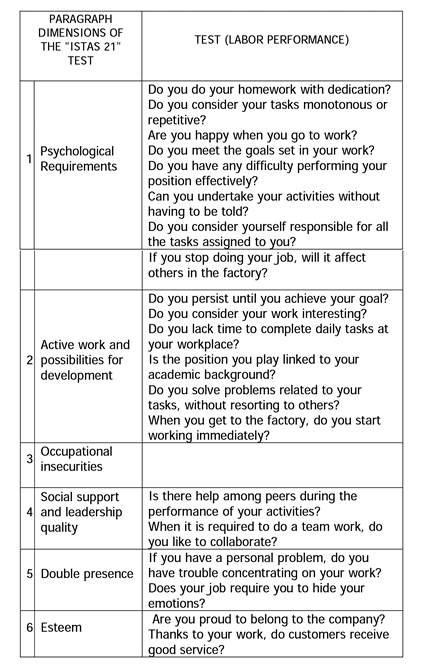
doi.org/10.15198/seeci.2017.44.33-51
RESEARCH
DOUBLE PRESENCE IN FEMININE WORKERS: BALANCE BETWEEN WORK AND FAMILY LIFE
LA DOBLE PRESENCIA EN LAS TRABAJADORAS FEMENINAS: EQUILIBRIO ENTRE EL TRABAJO Y LA VIDA FAMILIAR
A DUPLA PRESENÇA DAS TRABALHADORAS FEMININAS: EQUILIBRIO ENTRE O TRABALHO E A VIDA FAMILIAR
Paulina Ruiz López1
Paúl Pullas Tapia: Christian
Alberto Parra Parra
Ruth Zamora Sánchez
1Technical University of Ambato. Ecuador
paulinamruizl@uta.edu.ec
Technical University of Ambato. Ecuador
paulspullas@uta.edu.ec
Technical University of Ambato. Ecuador
albert_chris01@hotmail.es
University of the Basque Country UPV/EHU. Spain
ra.zamora001@ikasle.eus
Recibido: 29/04/2017
Aceptado: 15/06/2017
Publicado: 15/11/2017
ABSTRACT
In the present research we studied the “Double Presence”, which is one of the most important factors of psychosocial risks. It is to respond to the demands of paid work and domestic responsibilities, usually taking care of someone, that simultaneously can destabilize the balance about the life and the work that person seeks. This psychosocial risk largely affects the labor health of women, since they have often the role of caretakers and protectors of the home. The objective of this research was to analyze the “double presence” factor to know how it affects the persons in their workplace and personal life. The population object of this study corresponds to the textile company “Boman Sport”. The “Istas 21(CoPsoQ)”, psychological instrument was used, and a survey to verify if the psychosocial risk influence the labor performance was used.
KEY WORDS: Psychosocial Risks, Double Presence, Labor health, work, women, family, gender.
RESUMEN
En el presente trabajo de investigación se estudió la “Doble presencia”, que es uno de los más importantes factores de los riesgos psicosociales. Se trata de responder a las altas exigencias del trabajo asalariado y las responsabilidades domésticas, generalmente de cuidados, que simultáneamente desestabiliza el balance sobre la vida y el trabajo que busca la persona. Este riesgo psicosocial afecta en mayor medida a la salud laboral de las mujeres, ya que ellas poseen el rol de cuidadoras y protectoras del hogar. El objetivo de esta investigación fue analizar el factor Doble Presencia para saber cómo éste afecta a las personas en su puesto de su trabajo y vida personal. La población objeto de estudio corresponde a la empresa textil “Boman Sport”. Se usó el instrumento psicológico “Istas21 (CoPsoQ)” y una encuesta con el fin de comprobar si los riesgos psicosociales infulyen en el desempeño laboral.
PALAVRAS CHAVE: Riscos Psico-sociais, Dupla Presença, Saúde laboral, Trabalho, Mulheres, Família, Gênero.
RESUME
No presente trabalho de investigação estudou-se a ¨Dupla presença¨que é um dos mais importantes fatores de riscos psico-sociais. Trata-se de responder as altas exigências do trabalho assalariado e as responsabilidades domesticas, geralmente de cuidados, que simultaneamente desestabiliza o balance sobre a vida e o trabalho que busca essa pessoa. Esse risco psico-social afecta em maior grau a saúde laboral das mulheres, já que elas possuem um papel de cuidadoras e protetoras de suas casas. O objetivo desta investigação foi analisar o fator de dupla presença para saber como afeta as pessoas em seu posto de trabalho e vida pessoal. A população objetivo desse estudo corresponde à empresa têxtil ¨Boman Sport¨. Foi usado o instrumento psicológico ¨Istas21 (CoPsoQ)¨ e uma pesquisa com a finalidade de comprovar si os riscos psico-sociais influem no desempenho laboral.
PALAVRAS CHAVE: Riscos Psico-sociais, Dupla Presença, Saúde laboral, Trabalho, Mulheres, Família, Gênero.
How to cite this article
Ruíz López, P.; Pullas Tapia, P.; Alberto Parra, C.; Zamora Sánchez, R. (2017). Double presence in feminine workers: balance between work and family life. [La doble presencia en las trabajadoras femeninas: equilibrio entre el trabajo y la vida familiar] Revista de Comunicación de la SEECI, 44, 33-51 http://dx.doi.org/10.15198/seeci.2017.44.33-51 Recuperado de http://www.seeci.net/revista/index.php/seeci/article/view/476
1. INTRODUCTION
Double Presence is the name proposed by the Italian sociologist Laura Balbo, in the late 1970s, to represent the situation that characterizes the lives of the majority of women in today’s industrialized societies. This name evidences the daily life of those women who have to face the labor activity and domestic-family work as the only viable and unavoidable scenario.
This concept was born out of the reflections of feminism, in an attempt to consolidate equity between men and women in the family and work environment. While there has certainly been a breakthrough on the path of equality, but we are still far from that goal, so considering the Double Presence as another psychosocial risk, is an important step in combating it. Moreover, if we consider that 90% of women who work outside the home endure it, and this Double Presence directly affects the health of these women, with the most frequent symptoms being stress, anxiety, depression and musculoskeletal problems (Elvira Ramos, 2008: p 2).
Conceptualizing the risk factor called Double Presence is the work done, both as employees of paid work and that performed in family and domestic tasks, which is performed simultaneously by the same person, which causes an increase in the workload on the person.
Not having a free time in which the woman can take care of her personal activities is a sign of a contraindicated work rhythm. “An inadequate work rhythm is one in which the worker after his working day continues to work doing overtime, for which he sees his breaks reduced. This causes the worker to have a feeling of overwhelm and drowning with the work. “Calera, A. (2006) pp. 1-15
For this reason, the recruitment and selection process should be thorough and effective, so that women who are less likely to be seriously affected by psychosocial risks are chosen. The Law on the Prevention of Occupational Risks (Spain), in its article 16.2, stipulates the following: “The employer must carry out an initial evaluation of the risks for the safety and health of workers, taking into account, in general; the nature of the activity, the characteristics of the existing jobs and of the workers who must perform them “
At present, the feminine gender continues to be responsible for a large part of domestic-family work. The Double Presence means that during paid work time, the person must manage his / her domestic responsibilities and, during private time, must organize or otherwise manage his / her professional responsibilities. It should be emphasized that the risk factor referred to in this article is immersed in The Psychosocial Risks, a group that is within the Occupational Risks considered of interest by the Ministry of Labor of Ecuador.
Deepening the concept of Psychosocial Risk, it consists of interactions between work, its environment, job satisfaction and the conditions of the organization, on the one hand, and on the other, the worker’s capacities, his / her needs, his / her culture and his / her personal situation outside work, all of which, through perceptions and experiences, can influence health, performance and job satisfaction (ILO-WHO Joint Committee 1986: 3).
This shows us that psychosocial risk factors are the conditions to which the worker is exposed and that if this harmful condition is prolonged or intensified it will be transformed into the psychosocial risk already seen as a fact.
The consequences of the psychosocial risks are perceived by the worker and by the company, because the worker’s performance is affected, therefore, the productivity of the company would suffer a decrease. According to Chiavenato (2009) in the book “Human Talent Management”, he maintains that the work performance is those behaviors that are observed in the employees that are remarkable and essentially indispensable for the fulfillment of the objectives of an organization since they are employees who know how to do their work and not only do it for doing it, therefore these are essential aspects such as: the skills, behavior, discipline, and personal qualities that are demanded in the performance of certain job functions or positions.
As a consequence of the significant changes in organizations and processes of globalization today, the exposure to psychosocial risks has become more frequent and intense, making their identification, evaluation and control convenient and necessary in order to avoid their associated risks for the health and safety at work (EU-OSHA, 2007).
Psychosocial risks have become a reference in the detriment to employees’ occupational health, for that reason their study becomes essential to subtract or try to eliminate the harmful effects of these on the welfare of workers
Psychosocial risk creates any likelihood that a worker will suffer a certain damage to his or her physical or mental health, either from maladjustment of positions, methods and work processes to the worker’s competencies, or as a consequence of the negative influence of the organization and working conditions, as well as social relations in the company and any other “environmental factor” of work (Fernández R. 2010, p. 65).
Psychosocial risks are latent in every worker, the percentage in which they are exposed to a particular psychosocial risk factor, will determine how serious the consequences could be, both for physical and emotional health. In addition to those individual consequences, which are very detrimental to the employee’s well-being, there are also organizational consequences such as the employee’s performance in their paid work place.
Psychosocial factors may be convenient or inconvenient for the development of the work activity and for the quality of working life of the worker. In the first case they contribute positively to the personal development of the workers, while when they are unfavorable they have harmful consequences for their health and for their well-being. In this case we refer to psychosocial risk factors or sources of work stress and have the potential to cause psychological, physical, or social harm to workers. There are innumerable studies that have concluded that psychosocial risks are agents capable of deteriorating the health of people during the performance of their work and even outside it. (Gill-Monte 2008, p. 1)
It is important to emphasize that psychosocial risks cause imbalances that are reflected in their own person - physical and psychic - in their family environment and in the organization where they work.
Prado, J. (2014) states that “When the organization and content of work constitute a psychic threat, psychological changes occur, the individual activates the defense mechanisms that he has available to achieve equilibrium, by adapting to the new situation”. If the worker fails to establish the balance, it can lead to the appearance of psychological or emotional alterations that affect the individual not only in the workplace, primarily his performance but in his other spheres external to work.
As shown by Cox and Griffiths (1996), the effects of psychosocial stress factors can affect both psychological health and physical health through stress-activated psychophysiological mechanisms.
Early work by Selye (1956) revealed a general syndrome of stress-related adaptation. Other subsequent studies (Everly, 1989) made clear the activation of neural, endocrine and neuroendocrine axes which involved a preparation of the organism for the fight or flight response or resistance to threat and aggression. Subsequent studies have linked the immune system to the Stress response (Rabin, 1999; Sandin, 2001). Today there is a common agreement that the stress response implies a systemic modification of the organism (McEwen, 2002, Martínez Plaza, 2007). The paradox is that the response that prepares the body for its health can lead to illness (Selye, 1975).
Complementarily, in the workplace it was verified a close association between the psychosocial factors of risk and the damage to the health. Work-related stress would be the mediating psychophysiological agent between organizational work problems and health, physical and mental problems (Cox, Griffiths and Rial-Gonzalez, 2000).
Stress is of great importance since it is the first symptom by affecting the psychosocial risks, all psychosocial risks lead to stress, and stress subsequently triggers the different physiological and psychological consequences, because of this we have to understand everything that stress entails.
At the physical level the individual can suffer cases of stress, anxiety, muscular pains, cardiovascular diseases, etc. (Gil-Monte et al., 2006); At the psychic level, the mental load, etc.; in their family environment, conflict with their partner, discomfort by the noise of children, etc.; and, in the organization, loss of interest in the work, absence from work, conflict with colleagues, etc.
A very important point to consider is that not all women have the same resistance to psychosocial risk factors, it must be emphasized that the personality of every woman is not marked by a specific pattern, but is influenced by factors such as the level aspiration of the person, self-confidence, resistance to stress ... people with these skills are usually more efficient, responsible and active. In contrast, insecure, dependent, depressed people are more likely to suffer some form of psychological pathology such as anxiety, depression ... (Salgado, J. 2005, p. 115-117).
From the business point of view, one of the costliest consequences an organization must face is sick leave. It should also be borne in mind that psychosocial risks directly affect the quality of working life of workers (Garrido-Pinzón et al., 2011), which in turn influence their work performance, motivation, satisfaction with work done, among others. There are three consequences that these risks have on organizations and have been the most studied: absenteeism, work rotation and abandonment of work.
At present, this issue is still little recognized by employers or company managers; As a result of this, the system of control and prevention of psychosocial risks is minimal, which is detrimental to the health and well-being of the human talent of the organization.
For many workers it is too common for the workplace to be the place where they spend most of their waking hours. According to several surveys, many carry out activities that they perceive as demanding, restrictive, and otherwise stressful. Mental health problems and other stress-related disorders are recognized as one of the main causes of musculoskeletal discomfort and disorders, early termination of work, high absence rates and low productivity of the organization. That is why it is very important to recognize the importance of psychosocial risks. (European Risk Observatory Report held in 2012)
The physiological consequences of Double Presence are: stress, anxiety, depression and musculoskeletal injuries. In turn, there may also be social consequences, since their behavior influenced by a fast pace of life, in addition to physical and mental fatigue, can have variations in the attitude of women, sometimes making it somewhat hostile and hurting their job performance, labor relations, the work environment of the organization and its family and social environment.
However, the massive incorporation of women into the labor market has not been accompanied in the same proportion by a parallel incorporation of men into domestic work. This may be because the sexual division of labor continues to lay on the shoulders of women: the responsibility of the children and the household. The phenomenon of the Double Presence has become more evident as globalization advances and indications of this we find in the innumerable struggles that have been and have against gender equity in the world labor field.
2. OBJECTIVES
What this research shows is that women who are victims of the Double Presence need to be intervened, in order to promote their personal well-being under the framework of occupational health. In this context, the World Health Organization (1995: 60) considers occupational health as “a multidisciplinary activity aimed at promoting and protecting the health of workers”. This is achieved through a process of control and prevention of occupational accidents and diseases; It should also aim to eliminate any factor or condition that could negatively affect the health and safety of workers.
This research work aims to show the business community that the women who make up their human talent not only perform their salaried work, but also combine this activity with domestic tasks (Cladellas, 2008). In the case of not achieving a balance between the two spheres (labor-household / family), women workers are more likely to present deterioration in their health and quality of life; also affecting their performance within the organization.
According to the International Labor Organization (ILO), “Occupational health should aim to promote and maintain the highest level of physical, mental and social well-being of workers in all occupations.” So businessmen should promote the development of a good occupational health.
3. METHODOLOGY
3.1 Design and sample
A quantitative study was carried out in which the Psychosocial Risk Assessment Questionnaire at Work ISTAS21 (CoPsoQ) was applied in October 2016 to the 67 employees of the textile company “Boman”.
3.2 Instrument of data collection
The Psychosocial Risk Assessment Tool at Work ISTAS21 (CoPsoQ) was used as a short version, adapted for the Spanish language of the Psychosocial Questionnaire of Copenhagen (CoPsoQ); designed to initiate the risk assessment in small companies. This instrument identifies and measures exposure to six major groups of health risk factors of a psychosocial nature at work, such as psychological demands, active work and the possibility of development, Job Insecurity, Social Support and leadership quality, Double Presence and Esteem. The score of the questionnaire is given by a Likert scale, which is associated with each question, with a maximum of 5 points per question, where a higher score indicates a higher risk. From this, the scores of each dimension and sub-dimension were estimated by tertiles, in order to establish ranges: Low (exposure level more favorable to health), Medium (intermediate level) and High (exposure level more unfavorable to health). In addition, a survey was conducted to analyze the influence of psychosocial risks on work performance.
Matching Test Istas 21 and Survey

3.3 Study variable
The variable relative to one of the six dimensions existing in the Istas Instrument 21.
Double presence: It values the existence of synchronous and simultaneous demands, between the work environment and the domestic-family environment, considering that the need to respond to the demands of salaried work and domestic-family work can negatively affect health. The performance of salaried work and the domestic-family work can increase the demands and hours of work (double exposure or double work). In addition, the need to combine both works also poses a time conflict, since both are part of the same social reality, mainly for women, and present frequent interferences in the time and moment that it is necessary to respond to the demands of both spaces.
3.4 Statistical analysis
Responses were classified as High risk (most unfavorable psychosocial exposure to health), Medium risk level (intermediate psychosocial exposure) and Low risk level (most favorable health psychosocial exposure). Chi square (p <0.05) was also calculated, with the results of the survey, with a 95% confidence interval (CI).
4. DISCUSSION
In the first place, an evaluation of the work performance is carried out by means of the application of a survey that consists of 20 questions that seek to to identify the level of performance in all the personnel of the “Boman Sport” Co. Ltd company. Corresponding to 65 workers, obtaining as a result that the level of performance is not adequate, after a tabulation and analysis of each and every one of the questions. Subsequently, the psychological instrument that was used to carry out the study has been an adaptation to the Spanish of the Psychosocial Questionnaire of Copenhagen (COPSOQ) of the National Institute of Occupational Safety and Health of Denmark, which was created with the objective of evaluating occupational risks using a valid method. The adaptation to the Spanish language was called ISTAS21 (COPSOQ).
This instrument “Istas 21” has six psychosocial dimensions: Psychological requirements; Active work and possibilities of development; Insecurity; Social support and Leadership quality; Double Presence; And Esteem (Table 1).
This investigation was focused on the scale of the Double Presence, which was developed in collaboration with the Cabinet of Studies of Comisiones Obreras (CCOO) of Navarra, Spain. The Double Presence is a dimension not included in the original scale, but very interesting as it shows in many cases, that is, the double working day that the women endure (in the house y outside it), which adds another element to be taken into account in the approach of the labor health (Moncada et al., 2005).
Table nº 1 Results in the six dimensions by means of the instrument Istas 21
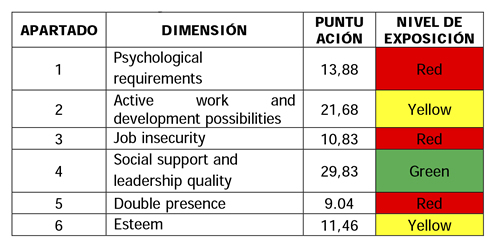
Green: level of psychosocial exposure more favorable for the health.
Yellow: level de psychosocial exposure intermediate.
Red: level de psychosocial exposure more unfavorable for the health.
According the Martín del Río Arteaga and Oscar Olivares Gómez in their “descriptive study with aims of prevention in the network of primary attention of the Commune of Quellón, Chile” 2010. As the results point out, the data of the Double Presence Dimension are confirmed in 52% of the sample, that is, that a high psychosocial risk is found. Which would speak of a reality in which the domestic worries have a significant weight as a stress factor in more than half of the workers.
At the gender level it can be stated that the domestic work load sub dimension is present in a riskier way in the female population. In turn, it can be stated that the category segment of Auxiliaries would have to arrive to work after work, which could point out that the group with more psychosocial risk in this dimension should be the one of auxiliary women of forty or more years.
Table nº 2. Classification of workers by gender

According to the appreciations of this investigation y and those mentioned before, the results agree in that the psychosocial risk named Double Presence is increasing with the passing of the years, and that the most affected population by this psychosocial risk is the female.
According to Marjory Güilgüiruca Retamal, Karina Meza Godoy, Rodolfo Góngora Cabrera, Cristóbal Moya Cañas in their study “Factors of psychosocial risk and stress perceived in workers of an electrical enterprise in Chile” 2015, it is possible to point out that the sociodemographic variables show a significant role with some factors of psychosocial risks of the work studied. Emphasizing the case of the women which show a greater magnitude of the Double Presence factor. This coincides with previous studies, where the interference of the work on the private-familiar life, is particularly demanding with them. Which is in direct relation with the greater number of hours that they assign to household labor, culturally associated to the role of gender. This evidence has important consequences for the mental health of those working women, emerging as a collective with greater vulnerability, so, the organizational measures that are directed to the healthy equilibrium with regard to the link between work and private life and family constitutes a necessary challenge for a modern management.
This last investigation which is referenced in research work, also holds that the psychosocial factor “double presence” is more habitual in the women as it is for them that the interference of the family life in their salaried work is more common. This existence of the double presence in the women would depend of the culture or region from which the sample is taken, but generally that would be the pattern in the majority of the countries.
In the Research Work “Double presence: a psychosocial risk that evidences the inequality between men and women in the conciliation of family and labor life” of the authors; Lucia Estevan Reina, Rosa Mª Rodríguez Sánchez, Borja Romero González, Álvaro Rodríguez López, Marina Romo Sola. Universidad de Granada.
It should be mentioned that while the first three dimensions described are positive, the last three are negative, which implies that obtaining high scores on active work, social support and esteem, would be a symptom of good health at work, while high in the last three (Double presence, psychological demands and insecurity) would be a symptom of poor occupational health.
Figure 1. Psychosocial risks in the work context
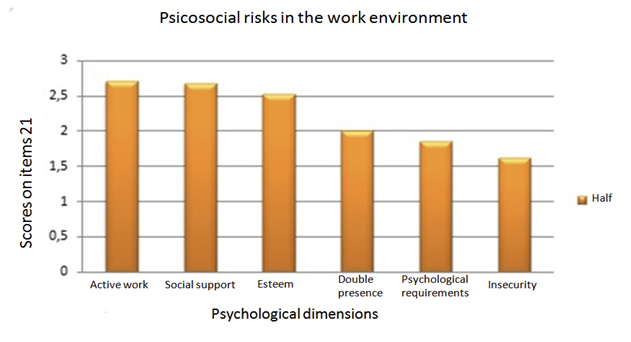
Prepared by: Lucia Reina, Rosa Rodríguez, Borja Romero, Álvaro Rodríguez and Marina Romo.
Source: Workers of the University of Granada
The dimension chosen in our research to analyze it in a more exhaustive way was the double presence, an ANOVA was applied to compare the differences in the scores regarding the sex. The results showed F (1,94) = 12 and p = 0.001, showing that there are significant differences in this dimension with respect to gender, with women having higher scores (N = 56, Mean = 2.25) than men (N = 40; Mean = 1.68).
Figure 2. Gender influence on double presence scores.
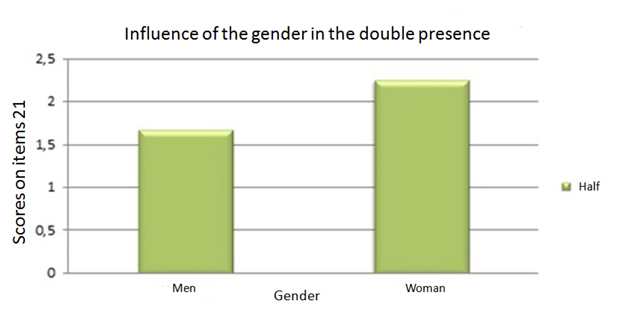
Prepared by: Lucia Reina, Rosa Rodríguez, Borja Romero, Álvaro Rodríguez and Marina Romo.
Source: Workers of the University of Granada
In this last investigation, and in agreement with the previous ones, it is demonstrated quantitatively and graphically that the double presence is the most prevalent psychosocial risk factor in the population of workers under study, and the one that most disfavors the employees’ occupational health .
Finally, we will contrast information from the research of Lenka Krej?í, Aleksandra ?akoma, Aleksandra Niedzia?kowska and Marta Nowotarska about the double presence in the Faculty of Education of the University of Granada.
As can be seen in the following table, most people are in the red range, that is 59 out of 87 people which is almost 68%. In turn, the least amount of people receives the green interval, only 8 people who are 9.2%.
Table nº 3 Result in the dimension of Double presence

Prepared by: Lenka Krej?í, Aleksandra ?akoma, Aleksandra Niedzia?kowska and Marta Nowotarska.
Source: Istas 21 applied to teachers of the Faculty of Education Sciences at the University of Granada
The results differ due to gender. That is, women receive higher scores than men for each one of the questions.
Table nº 4 Result in the dimension of Double presence

Prepared by: Lenka Krej?í, Aleksandra ?akoma, Aleksandra Niedzia?kowska and Marta Nowotarska.
Source: Istas 21 applied to teachers of the Faculty of Education Sciences at the University of Granada
The results obtained in the present study indicate that the factor of the Double Presence is a problem for the employees of the Faculty of Education Sciences at the University of Granada. It seems that women in this sense are significantly more affected than men. It is possible that age also influences to a certain extent, although a significant difference between the different age groups was not found.
According to José Manuel Tomás, Amparo Oliver, María Dolores Sancerni, In his “Summary Report of the Psychosocial Risks Survey of the University of Valencia” There are relevant effects on the health of a specific series of psychosocial risks. In particular, three of them. What most health problems (stress) generate in the sample are insecurity in employment, double presence and, especially, the emotional demand. This means, in view of the effects, that those who are more insecure, have more responsibilities at home and are subjected to more emotional demands are more likely to have health problems and stress.
Table nº 5 ISTAS traffic light in general sample: average risks
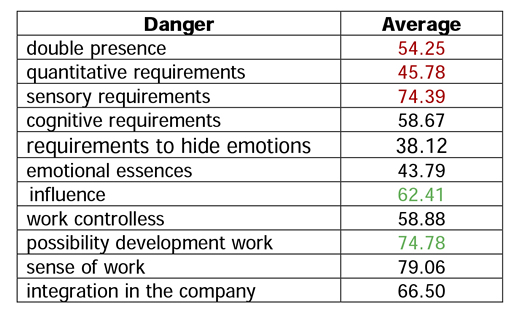
The ISTAS method includes, for the interpretation of the obtained results, an intuitive guide consisting of a traffic light that identifies poor values with red, intermediate ones without highlighting in color and green if they indicate a situation better than the reference standard.
As indicated by the results presented and in agreement with the investigated in the present study, there are harmful effects on health especially in three psychosocial risks, among them is the double presence, which is object of study in this research, where the workers who have more responsibilities at home and are subjected to more emotional demands are the most harmed.
It is necessary to consider that one of the factors that most affects in the psychosocial risk Double Presence is the direct relationship that exists between the greater number of hours worked and the ones dedicated to the domestic tasks, culturally associated to the gender role. This evidence has important consequences for the mental health of these working women, emerging as a group with greater vulnerability. For this reason, in terms of organizational measures aimed at achieving a healthy balance in the area of work-private life and family, it is a necessary challenge for modern business management. This existence of Double Presence in women would depend on the culture or region from which the sample is taken, but generally this would be the pattern in most countries.
Calculation of Chi-square
With 6 degrees of freedom and a level of 0.05 we have in the table of X2 the value of 12.59, therefore, we accept the null hypothesis for any value of chi square that is up to the value 12,59 and we reject the Hypothesis when the calculated values are greater than 12.59.
Table nº 6 Calculation of χ²
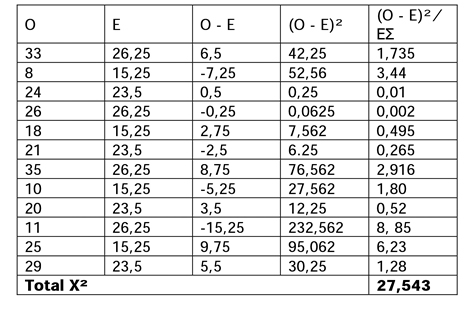
Gauss bell
Figure 3 Gauss Bell Chart
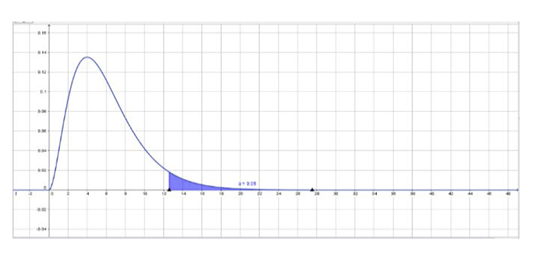
For 6 degrees of freedom at a level of 0.0,5 12.591 is obtained in the table and because the value of the calculated chi-square is 27.543 it is outside the acceptance region, then the null hypothesis is rejected, so the Alternative hypothesis that says: “The psychosocial risks affect the work performance of the employees of the Textile Company” BOMAN SPORT “Cia. Ltda.”
5. CONCLUSIONS
In general, organizations, both public and private, tend to focus more on protecting their workers from the physical risks they may face in their workplace than from psychosocial risks. The factors that affect workers are almost always the same. However, the nuance will be different depending on the activity performed by the individuals, the environment in which they perform the activity and the burden of tasks outside working hours.
The need to respond to labor demands and the fulfillment of domestic-family tasks can adversely affect the health and performance of employees. It can also lead to a lack of coordination in the organization of time and cause a feeling of overload.
Psychosocial risks can affect all people regardless of gender; However, it is the female sector that it affects more negatively, as we have seen in our results. However, this may vary according to the individual’s culture or demographic position.
The incorporation of the feminine gender in the labor field has increased in recent years and will continue to increase, so that the psychosocial risk denominated Double Presence will tend to affect the health and personal well-being of more women. So their study becomes fundamental to try to control and prevent this psychosocial risk.
6. RECOMMENDATIONS
For the benefit of workers, as well as for the enterprise, it is considered appropriate to design flexible work schedules that allow workers, especially women, to combine their labor responsibilities with household tasks.
Similarly, it is recommended that companies design an Industrial Safety manual for the location of psychosocial risks, especially the “Double presence” that affects the female sector, which can harm their workers. A healthy work environment will generate greater labor well-being among workers.
Finally, human Talent departments should schedule “Conciliation of family, personal and work life” talks where the balanced distribution of domestic tasks among all members of the family is promoted.
7. REFERENCES
1. Calera A (2003). Tiempos y ritmos de trabajo. Incidencias en la salud. Madrid: CCOO.
2. Chiavenato I (2009). Gestión del Talento Humano. México: Editorial McGraw Hill.
3. Cladellas R (2008). La ausencia de gestión de tiempo como factor de riesgo psicosocial en el trabajo. Intangible Capital, 4(4):237-254.
4. Comité Mixto OIT/OMS sobre Higiene del Trabajo. Committee on Occupational Health, World Health Organization, International Labour Organization. Ginebra.
5. Cox T, Griffiths AJ (1996). The assessment of psychosocial hazards at work. En Schabracq MJ, Winnubst JAM, Cooper CL (eds.), Handbook of Work and Health Psychology. Chichester: Wiley and Sons. 127-146.
6. Del Río Arteaga M, Olivares Gómez O (2010). Estudio descriptivo con fines de prevención en la red de atención primaria de la Comuna de Quellón, Chile. Medwave, 10(09):e4779. doi: 10.5867/medwave.2010.09.4779.
7. EU-OSHA (2007). Expert forecast on emerging psychosocial risks related to occupational safety and health. Luxemburgo: Comunidades Europeas.
8. European Risk Observatory Report (2012). Management of psychosocial risks at work: An analysis of the findings of the European Survey of Enterprises on New and Emerging Risks. Bilbao: European Agency for Safety and Health at work.
9. Everly GS (1989). A clinical Guide to the treatment of the human stress response. New York: Plenum.
10. Fernández R (2010). La Productividad y el riesgo psicosocial o derivado de la organización del trabajo. Alicante: Editorial Club Universitario.
11. Garrido-Pinzón J, Uribe-Rodríguez A, Blanch JM (2011). Riesgos psicosociales desde la perspectiva de la calidad de vida laboral. Acta Colombiana de Psicología, 14(2):27-34.
12. Gil-Monte P, Nuñez-Román E, Selva-Santoyo Y (2006). Relación entre el síndrome de quemarse por el trabajo (Burnout) y síntomas cardiovasculares: un estudio en técnicos de prevención de riesgos laborales. Revista Interamericana de Psicología, 40(2):227-232.
13. Gill-Monte P (2009). Algunas razones para considerar los riesgos psicosociales en el trabajo y sus consecuencias en la salud pública. Revista Española de Salud Pública, 83(2):169-173.
14. Krej?í L, ?akoma A, Niedzia?kowska A, Nowotarska M (2014). La doble presencia en la Facultad de Educación de La Universidad de Granada. Reidocrea, 3, artículo 25.
15. LEY 31/1995, de 8 de noviembre, de Prevención de Riesgos Laborales. BOE nº 269 10- 11-1995, España.
16. Güilgüiruca Retamal M, Meza Godoy K, Góngora Cabrera R, Moya Cañas C (2015). Factores de riesgo psicosocial y estrés percibido en trabajadores de una empresa eléctrica en Chile. Medicina y Seguridad en el Trabajo, 61(238):57-67.
17. Martinez Plaza CA (2007). Estrés. Aspectos Médicos. Madrid: INSHT.
18. Mc Ewen B (2002). The end of the stress as we know it. Washington: Joseph Henry Press.
19. Organización Internacional del Trabajo (OIT) (1986). Methods used in Establishing Permissible Levels in Occupational Exposure to Harmful Agents. Technical Report, 601. Ginebra: OIT.
20. Organización Mundial de la Salud (1995). Salud ocupacional para todos. http://apps.who.int/iris/bitstream/10665/42109/1/951802071X_spa.pdf
21. Prado J (2014). Riesgos psicosociales para el individuo y la empresa. http://www.imf-formacion.com/blog/prevencion-riesgos-laborales/actualidad-laboral/consecuencias-de-los-riesgos-psicosociales-para-el-individuo/
22. Rabin BS (1999). Stress, immune function and health. New York: Wiley.
23. Ramos E (2008). Doble presencia: salud y prevención. Clave Sindical, 5, 16-18.
24. Reina L, Rodríguez R, Romero B, López Á, Romo M (2014). Doble presencia: un riesgo psicosocial que evidencia la desigualdad entre hombres y mujeres en la conciliación de la vida familiar y laboral. Reidocrea, 3, artículo 22.
25. Salgado J (2005). Personalidad y Deseabilidad social en contextos organizacionales: Implicaciones para la práctica de la psicología del trabajo y las organizaciones. Papeles de psicólogo, 92(26):115-117.
26. Sandin B (2001). Estrés, hormonas y psicopatología. Madrid: Klinik.
27. Selye H (1956). The stress of life. New York: McGraw Hill.
28. Tomás JT, Oliver A, Sancerni MD. Informe resumido de la encuesta de riesgos psicosociales de la Universidad de Valencia.
AUTHORS
Paulina Margarita Ruiz López
Psicóloga Educativa y Orientadora Vocacional. Magister en Diseño Curricular y Evaluación Educativa. Doctorando en Ciencias de la Educación Universidad de la Plata (Argentina). Docente – Investigador Universidad Técnica de Ambato
http://orcid.org/0000-0001-8472-0504
Christian Alberto Parra Parra
Psicólogo Industrial. Empresa Pública Municipal de Agua Potable y Alcantarillado Ambato, Sector Público. Pasante en la Dirección Administrativa, Área de Talento Humano
Paul Santiago Pullas Tapia
Licenciado en Ciencias de la Educación especialidad Pedagogía. Magister en Psicopedagogía con mención en Talento y Creatividad. Doctorando en Pedagogía Aplicada por la Universidad Autónoma de Barcelona (España). Docente - Coordinador/Director de las carreras: Psicología Industrial, Psicología Educativa, Docencia en Informática, Psicopedagogía. Universidad Técnica de Ambato
http://0000-0003-2176-941X
Ruth Armenia Zamora Sánchez
Licenciada en Administración de empresas. Master en Dirección Empresarial. Doctorando del Programa de Dirección Empresarial, Conocimiento e Innovación por la Universidad del país Vasco UPV/EHU, España.
http://0000-0003-4982-8741